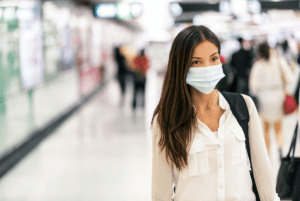9/14/21—Risk management is a crucial element to protecting employees, and in return protecting the continuity and productivity of your company. Over the last 18 months as the world dealt, and continues to deal, with the COVID-19 pandemic, risk management took on a whole new scope, with employers struggling to keep businesses open, and retain and protect their workforce during ongoing surges. According to the UN International Labour Organization (ILO), job loss or reduced work hours due to COVID-19 cost the world 255 million jobs in 2020, noting the “massive impact” was nearly four times the number lost during the 2009 global financial crisis. The same report estimated an 8.3% decline in global income that same year.1 A risk management plan is more vital than ever to protect employees and business sustainability and profit.
When designing a risk management plan for COVID-19, start by creating a framework of potential risks. Risks include contamination of equipment, employee workspace and distancing, ventilation issues in the workspace, and areas of high traffic where transmission could be greatest. Tailor your plan to your specific workplace, for example a restaurant with a revolving door of customers versus a warehouse environment of only employees will have vastly different policies, as the ability to limit people on the premises helps decrease COVID-19 risk. Therefore, a business such as a restaurant should consider more prevention methods, like requiring customer compliance to safety guidelines and providing employees with more Personal Protective Equipment (PPE).
Arming yourself with updated guidelines and applying them to your plan is another key step, as guidelines for safety continue to evolve with growing variants, vaccine availability and more factors. The Centers for Disease Control and Prevention (CDC), provides updates regularly on safe practices for employers. Updating your policies regularly ensures that as the pandemic continues to change, you adapt accordingly. The CDC recommends several measures, including vaccination education and provisions for employees to receive vaccinations, health checks upon entering work premises, social distancing practices, contact tracing within the business, proper and regular sanitization and cleaning, and healthy employee hygiene.2
Once you have the risk and safety knowledge necessary, apply that information to your specific business practices. This means ensuring that workspaces are well-ventilated, employees are properly distanced when and where they can be, PPE is provided to each employee, employees practice proper hygiene, and contact tracing is setup, which can be done easily thanks to programs like AlertTrace. Ensure all employees are informed of the safety practices and standards in your risk management plan, and ask for feedback from them, as they can provide knowledge of possible risk factors you may not be aware of during a regular workday.
Another element necessary for a successful risk management plan is a chain of command established for any scenario. Employees need to know who they report to, and who they can go to with any concerns, to do their job efficiently. Setup a successor, or two even, for any high-level position that oversees any number of employees. Once you have established a chain of command, ensure all employees are informed, or have each manager inform their team. This step will help maintain a streamlined workflow, where employees and managers are able to adapt and evolve based on any sudden illnesses in the workplace.
Once you’ve setup a plan for proper practices, sanitization and employee safety, establish a plan for employees who become sick. Encourage employees to stay home when sick by eliminating negative consequences for missing work. The American Rescue Plan (ARP), setup by the Biden Administration, is one resource which provides monetary aid to pay employees for sick leave and provides tax credits to businesses for doing so.3 Using these resources and encouraging employee health as a priority not only helps to protect your business, but provides employees with a sense of mental ease, knowing their jobs are not at risk should their health need to be addressed. The ARP also applies to employees who must miss work to care for a sick loved one, which is another way to facilitate mental wellbeing in your workforce.
Finally, essential to risk management is what to do if an employee tests positive for COVID in your company. While social distancing and PPE are effective mitigators of spread, contact tracing is an essential measure of prevention and can greatly decrease or limit COVID spread in your company. AlertTrace provides peace of mind with easy implementation, easy adaptation to any workplace size and scale, and ease of use with mini wearables that provide accurate contact tracing data. Utilizing AlertTrace contact tracing as a part of your risk management plan can not only mitigate spread but stop it in its tracks when a positive case is detected. Being able to act quickly with reliable data can make all the difference in keeping your workforce healthy and plentiful, and your business productive and open.
…
1 United Nations. (n.d.). COVID’s led TO ‘massive’ income and productivity LOSSES, Un Labour estimates show | | UN NEWS. United Nations. Retrieved September 14, 2021, from https://news.un.org/en/story/2021/01/1082852.
2 Centers for Disease Control and Prevention. (n.d.). Covid-19 guidance: Businesses and employers. Centers for Disease Control and Prevention. Retrieved September 14, 2021, from https://www.cdc.gov/coronavirus/2019-ncov/community/guidance-business-response.html.
3 Employer tax credits for employee paid leave due to Covid-19: Internal Revenue Service. Employer tax credits for employee paid leave due to COVID-19 | Internal Revenue Service. (n.d.). Retrieved September 14, 2021, from https://www.irs.gov/newsroom/employer-tax-credits-for-employee-paid-leave-due-to-covid-19.
World Health Organization. (n.d.). Getting your workplace ready for covid-19: HOW Covid-19 spreads. World Health Organization. Retrieved September 14, 2021, from https://www.who.int/publications/i/item/getting-your-workplace-ready-for-covid-19-how-covid-19-spreads.




